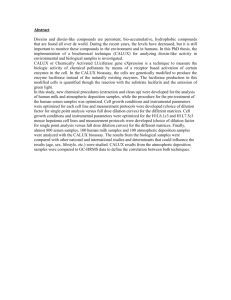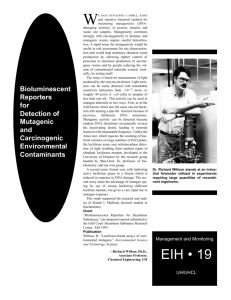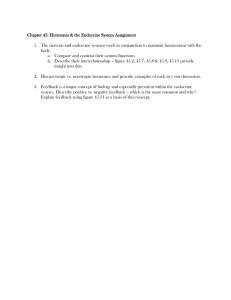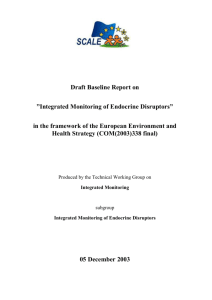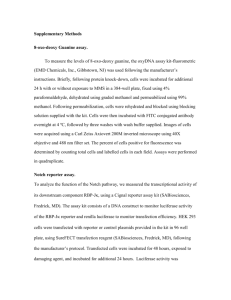Biological analysis of endocrine-disrupting chemicals in animal meats
advertisement
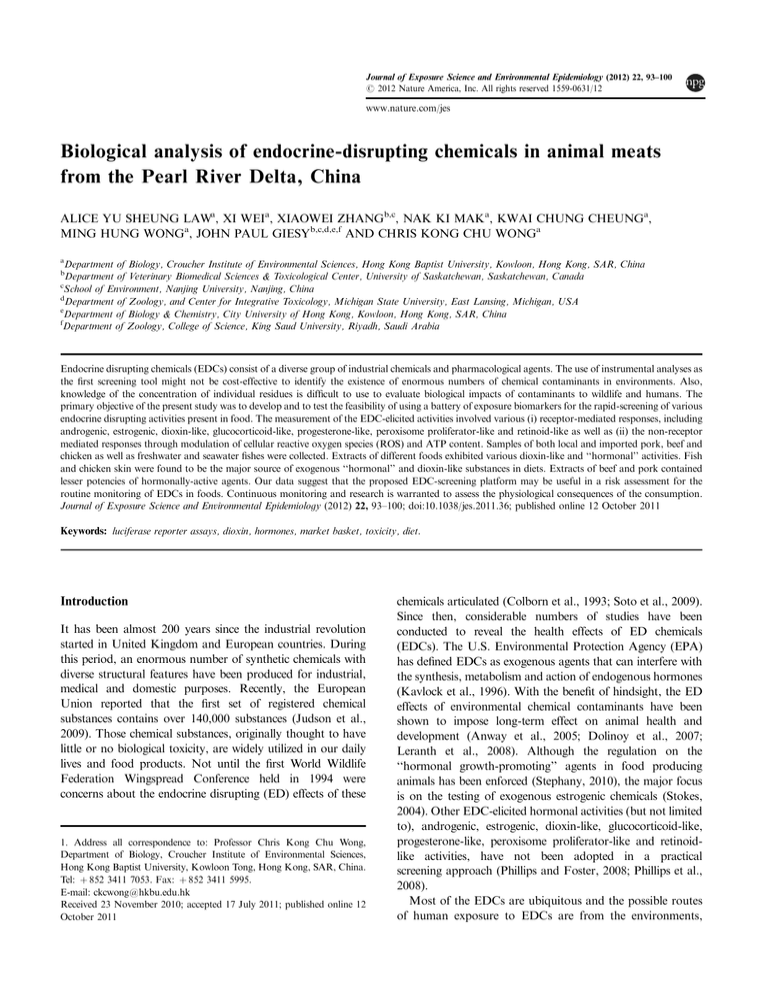
Journal of Exposure Science and Environmental Epidemiology (2012) 22, 93–100 r 2012 Nature America, Inc. All rights reserved 1559-0631/12 www.nature.com/jes Biological analysis of endocrine-disrupting chemicals in animal meats from the Pearl River Delta, China ALICE YU SHEUNG LAWa, XI WEIa, XIAOWEI ZHANGb,c, NAK KI MAKa, KWAI CHUNG CHEUNGa, MING HUNG WONGa, JOHN PAUL GIESYb,c,d,e,f AND CHRIS KONG CHU WONGa a Department of Biology, Croucher Institute of Environmental Sciences, Hong Kong Baptist University, Kowloon, Hong Kong, SAR, China Department of Veterinary Biomedical Sciences & Toxicological Center, University of Saskatchewan, Saskatchewan, Canada c School of Environment, Nanjing University, Nanjing, China d Department of Zoology, and Center for Integrative Toxicology, Michigan State University, East Lansing, Michigan, USA e Department of Biology & Chemistry, City University of Hong Kong, Kowloon, Hong Kong, SAR, China f Department of Zoology, College of Science, King Saud University, Riyadh, Saudi Arabia b Endocrine disrupting chemicals (EDCs) consist of a diverse group of industrial chemicals and pharmacological agents. The use of instrumental analyses as the first screening tool might not be cost-effective to identify the existence of enormous numbers of chemical contaminants in environments. Also, knowledge of the concentration of individual residues is difficult to use to evaluate biological impacts of contaminants to wildlife and humans. The primary objective of the present study was to develop and to test the feasibility of using a battery of exposure biomarkers for the rapid-screening of various endocrine disrupting activities present in food. The measurement of the EDC-elicited activities involved various (i) receptor-mediated responses, including androgenic, estrogenic, dioxin-like, glucocorticoid-like, progesterone-like, peroxisome proliferator-like and retinoid-like as well as (ii) the non-receptor mediated responses through modulation of cellular reactive oxygen species (ROS) and ATP content. Samples of both local and imported pork, beef and chicken as well as freshwater and seawater fishes were collected. Extracts of different foods exhibited various dioxin-like and ‘‘hormonal’’ activities. Fish and chicken skin were found to be the major source of exogenous ‘‘hormonal’’ and dioxin-like substances in diets. Extracts of beef and pork contained lesser potencies of hormonally-active agents. Our data suggest that the proposed EDC-screening platform may be useful in a risk assessment for the routine monitoring of EDCs in foods. Continuous monitoring and research is warranted to assess the physiological consequences of the consumption. Journal of Exposure Science and Environmental Epidemiology (2012) 22, 93–100; doi:10.1038/jes.2011.36; published online 12 October 2011 Keywords: luciferase reporter assays, dioxin, hormones, market basket, toxicity, diet. Introduction It has been almost 200 years since the industrial revolution started in United Kingdom and European countries. During this period, an enormous number of synthetic chemicals with diverse structural features have been produced for industrial, medical and domestic purposes. Recently, the European Union reported that the first set of registered chemical substances contains over 140,000 substances (Judson et al., 2009). Those chemical substances, originally thought to have little or no biological toxicity, are widely utilized in our daily lives and food products. Not until the first World Wildlife Federation Wingspread Conference held in 1994 were concerns about the endocrine disrupting (ED) effects of these 1. Address all correspondence to: Professor Chris Kong Chu Wong, Department of Biology, Croucher Institute of Environmental Sciences, Hong Kong Baptist University, Kowloon Tong, Hong Kong, SAR, China. Tel: þ 852 3411 7053. Fax: þ 852 3411 5995. E-mail: ckcwong@hkbu.edu.hk Received 23 November 2010; accepted 17 July 2011; published online 12 October 2011 chemicals articulated (Colborn et al., 1993; Soto et al., 2009). Since then, considerable numbers of studies have been conducted to reveal the health effects of ED chemicals (EDCs). The U.S. Environmental Protection Agency (EPA) has defined EDCs as exogenous agents that can interfere with the synthesis, metabolism and action of endogenous hormones (Kavlock et al., 1996). With the benefit of hindsight, the ED effects of environmental chemical contaminants have been shown to impose long-term effect on animal health and development (Anway et al., 2005; Dolinoy et al., 2007; Leranth et al., 2008). Although the regulation on the ‘‘hormonal growth-promoting’’ agents in food producing animals has been enforced (Stephany, 2010), the major focus is on the testing of exogenous estrogenic chemicals (Stokes, 2004). Other EDC-elicited hormonal activities (but not limited to), androgenic, estrogenic, dioxin-like, glucocorticoid-like, progesterone-like, peroxisome proliferator-like and retinoidlike activities, have not been adopted in a practical screening approach (Phillips and Foster, 2008; Phillips et al., 2008). Most of the EDCs are ubiquitous and the possible routes of human exposure to EDCs are from the environments, Law et al. consumer products and foods (Poppenga, 2000; Feron et al., 2002; Mantovani et al., 2006; Wigle et al., 2008). Among these routes, the most important pathway for human exposure to EDCs is via food consumption (Liem et al., 2000), contributing over 90% of total exposure in one’s lifetime. Owing to the large number of EDCs of heterogeneous structures, it is impractical to use chemical-analytical approaches as the first screening tool to monitor their levels in the high-volume consumer products (Judson et al., 2009). Hence in the present study, a battery of bioassays was used to screen food for both receptor-mediated and non-receptormediated EDCs. Local and imported animal meats, such as chicken, pork and beef, and fish, were collected for the detection of the residual ‘‘hormonal’’ and dioxin-like activities, as well as the biological activities related to the disturbance of cellular oxidative stress and energy levels. Materials and methods Food Sample Preparation Samples of meats were purchased from local markets in Hong Kong. For each type of meat, at least three individual samples were collected. For chicken wing, skin or meat were dissected and were analyzed separately. All samples were freeze-dried and extracted as described previously (Cheung et al., 2007). Briefly the freeze-dried sample (3 g) was mixed with 50 ml of dichloromethane:acetone (1:1), and was Soxhlet extracted in a shaking incubator (JULABO Labortechnik, GMBH, Seelbach, West Germany) at 40 1C for 18 h. The organic phase was collected and was then concentrated using a rotary evaporator (BÜCHI) at 60 1C until 2 ml of solution was left. The solution was cleaned up using a micro-florisil column with 10 ml of dichloromethane:hexane (1:1) as an elutant. The solution was then evaporated with a gentle stream of nitrogen until 5 ml of solvent was obtained. Of which 1 ml of the solution was used for fat content measurement by solvent evaporation until a constant weight was obtained. The rest of the 4 ml aliquant was further cleaned up by a gel permeation chromatography (GPC, Gilson, USA) to remove residual fat tainted in the solvent. A total of 600 ml of the extract was transferred into a vial and was evaporated to dryness under stream of nitrogen. Samples were re-dissolved in 100 ml of dimethylsulfoxide (DMSO, Sigma, St Louis, MO, USA) and were then used in different bioassays. 3-(4, 5-Dimethyl-2-thiazolyl)-2, 5-diphenyl-2Htetrazolium Bromide (MTT) Assay The human nasopharyngeal carcinoma cell line, CNE2 and the human breast cancer cell line, MCF7 were grown in RPMI-1640 supplemented with 10% FBS (HyClone, Perbio, Thermo Fisher Scientific, Cramlington, UK) and antibiotics (50 U/ml penicillin and 50 mg/ml streptomycin) 94 Biological analysis of EDCs in food (Invitrogen, Carlsbad, CA, USA). For the MTT assay, CNE2 cells were plated in triplicate into 96-well plates (Iwaki, Tokyo, Japan) at a density reaching 70–80% confluence by the time of adding the food extracts. After 24 h incubation with the extracts in 5% CO2 at 37 1C, the cells were incubated with 250 mg/ml MTT (Sigma) for another 3 h for the development of coloration, blue formazan. The medium was then removed, and the blue formazan was dissolved in 100 ml of DMSO. Optical density (OD) was measured at 570 nm with a micro-plate reader (BioTek, Winooski, USA). ATP Assay CNE2 cells were plated in triplicate into 24-well plates (Iwaki) at a density reaching 70–80% confluence by the time of adding the food extracts. After 24 h incubation with the extracts, the cells were lysed in a passive lysis buffer (Promega, Madison, WI, USA). After centrifugation at 10,000 g for 2 min, 10 ml of the supernatant were used to measure cellular ATP levels using an ATP determination kit according to the manufacturer’s instruction (Molecular Probes, Invitrogen). Luciferin-luciferase luminescence was measured by a multilabel reader VICTOR X4 (PerkinElmer, Waltham, MA, USA). Detection of Intracellular Reactive Oxygen Species (ROS) CNE2 cells were plated in triplicate into 96-well plates. After 24 h incubation with the extracts, ROS was measured by an incubation of the cells with 10 mM H2DCF-DA (Molecular Probes, Invitrogen) for 30 min. DCF fluorescence was measured at Ex495 nm/Em530 nm using the multilabel reader VICTOR X4. Reporter Plasmids The human androgen responsive element (ARE), dioxin responsive element (DRE) and glucocorticoid responsive element (GRE) luciferase reporters were constructed from human IGF-1 promoter (-1426/-1294), human CYP1A1 promoter (-1392/-874) and human gilz promoter (-1940/-1525), respectively. The IGF-1 promoter fragment contains two AREs, the CYP1A1 promoter segment contains five DREs, whereas the gilz promoter segment contains four GREs. The respective promoters were amplified by a high-fidelity Taq DNA polymerase (Invitrogen) using respective primers (Table 1) and human genomic DNA (Roche, USA). The PCR products were purified using a gel extraction kit according to the manufacturer’s instruction (Qiagen, Valencia, CA, USA). The sequences of the PCR products were verified by DNA sequencing (Tech Dragon, Hong Kong), and were then cloned into pGL3-SV40 vector (Promega). A human estrogen receptor-a (ERa) and a human estrogen responsive element (ERE) reporter gene, pGL2-ERE-luc were gifts from Dr. Calvin Lee (University of Hong Kong). The human androgen receptor Journal of Exposure Science and Environmental Epidemiology (2012) 22(1) Law et al. Biological analysis of EDCs in food Table 1. Primers used for the amplification of regions of ARE, DRE and GRE from the upstream respected human gene promoter. Construct Human promoter Forward primer (50 -30 ) Reverse primer (50 -30 ) pGL3-ARE-SV40 pGL3-DRE-SV40 pGL3-GRE-SV40 IGF-1 CYP1A1 gilz GGGCACATAGTAGAGCTCACAAAATG CCGGCTAGCTTGCGTGCGCC GTGCAGAGGGCAAATTAATA TGAGTCTTCTGTGTGGTTAATACATTG GCCAGGTTGAGCTAGGCACGCAAAT CAAATGCAGTCTGAAGGCCT (AR) was developed at the University of Saskatchewan. Reporter constructs for human progesterone responsive element (PRE), retinoic acid receptor response element (RARE), peroxisome proliferator-activated receptor gamma (PPARg) responsive element (PPRE) were purchased from Addgene, USA. Reporter Assay The day before transfection, MCF7 or CNE2 cells were plated into 24-well tissue culture dishes at a density reaching 70–80% confluence by the time of transfection. Transfection was performed using LipofectAMINE 2000 reagent (Invitrogen) and OPTI-MEM I medium, (GIBCO, USA) with 250 ng of reporter of interest. The luciferase construct was cotransfected with an internal control, 15 ng of pRL-SV40 plasmid (Promega) to normalize the transfection efficiency. Six hours after transfection, the transfection medium was replaced by a complete medium (phenol-red free RPMI-1640 medium with 10% charcoal-striped serum), and the food extracts was added. The culture was then incubated for 24 h in 5% CO2 at 37 1C. The cells were then lysed in the passive lysis buffer. After centrifugation, 20 ml of the supernatant were used to measure the luciferase activities. Firefly and Renilla luciferase activities were sequentially measured from a same sample using the Dual-Luciferase reporter assay system (Promega) and the multilabel reader VICTOR X4. Statistical Analysis Drugs treatments were performed in triplicate in the same experiments and individual experiments were repeated at least three times. All data are represented as the mean±SEM. Statistical significance was assessed with a Student’s t-test or one-way analysis of variance (ANOVA) followed by Duncan’s multiple range test. Groups were considered significantly different if Po0.05. Results and discussion Strategy for the Screening of EDC Contamination in Common Food Items EDCs can directly and/or indirectly alter the normal functions of endocrine system in vertebrates, leading to the disturbances of reproduction, growth and development (Sanderson 2006; Diamanti-Kandarakis et al., 2009, 2010). Journal of Exposure Science and Environmental Epidemiology (2012) 22(1) Cell Viability Assay (MTT) Pre-screening Redox/Cellular ATP Levels Endocrine Endocrine Disruptors Disruptors Prescreening Prescreening GRE Luciferase ARE Luciferase PRE PRE Luciferase Luciferase DRE DRE Luciferase Luciferase ERE ERE Luciferase Luciferase PPRE PPRE Luciferase Luciferase RARE RARE Luciferase Luciferase Analysis Analysis Figure 1. The flow chart indicates the strategy of using a battery of bioassays to detect non-receptor and receptor-mediated activities. There has been increasing concern on the roles of EDCs in the etiology of metabolic diseases and cancer (DiamantiKandarakis et al., 2009; Soto et al., 2009; Swedenborg et al., 2009; Soto and Sonnenschein, 2010). To safeguard the public health, instrumental chemical analysis has been adopted globally for assessing the risk of human exposure to EDCs and their metabolites (Hotchkiss et al., 2008). However, in view of the large inventories of man-made chemicals, the chemical-analytical approach cannot be used as a high-throughput screening tool to elucidate the presence of both known and unknown chemical contaminants (Judson et al., 2009). In addition the possible ‘‘biological’’ activities of the EDCs might not be revealed (Wei et al., 2010). In the present study, we aimed to illustrate the work plan of using a battery of bioassays to apply for the high-throughput screening of EDC contamination in daily food basket (Figure 1). Before identification of cellular responses to the sample extracts, the possible cytotoxic effects were assessed by MTT assay. The purpose of the assay is to evaluate if the sample extracts contained chemicals that can cause cell death 95 Law et al. Biological analysis of EDCs in food directly, as this would considerably affect the accuracy of the subsequent bioassays. In this study, a total of 84 samples were collected including pork, beef, chicken and fish, supplied from different countries of origin, such as North America, Brazil, China and Hong Kong. No cytotoxicity was observed for any of the sample extracts (Figures 2a and 3a). In the absence of cytotoxicity, non-specific (i.e., cellular ROS/ATP levels) and specific MTT assay a Beef Chicken Skin 0.5 OD 490 nm 0.4 Pork Meat a a a a a a H A a a a a C H A a a a a a C H A B a a 0.3 0.2 0.1 0.0 Ctrl B C B B H A ATP assay b Beef Chicken Skin 5 4 µM/ mg protein C a a Pork Meat a a a C H A a a a a a a a a C H A B C H A a a a C H a 3 2 1 0 Ctrl B B B A ROS assay c Chicken Skin a 4.0 Beef Pork Meat DCF fluorescence b 3.0 c c c d c d d d 2.0 d d d d d d d H A B C H A 1.0 0.0 Ctrl B C H A B C H A B C B – Brazil C – China H – Hong Kong A – America Figure 2. The effects of beef, pork, chicken meat & skin extracts on (a) cell viability, (b) cellular ATP and (c) ROS levels. 96 Journal of Exposure Science and Environmental Epidemiology (2012) 22(1) Law et al. Biological analysis of EDCs in food MTT assay 0.4 a a a a a a OD 490 nm 0.3 0.2 0.1 0.0 Ctrl GC SS OS BE BF ATP assay 5 a µM/ mg protein 4 a a a a a 3 2 1 0 Ctrl GC SS OS BE BF ROS assay a a a a DCF fluorescence 2.0 a a 1.5 1.0 0.5 0.0 Ctrl GC SS OS BE BF GC- Grass Carp SS- Spotted Snakehead OS- Orange-spotted grouper BE- Bigeye BF- Bartail Flathead Figure 3. The effects of fish meat extracts on (a) cell viability, (b) cellular ATP and (c) ROS levels. Journal of Exposure Science and Environmental Epidemiology (2012) 22(1) responses (i.e., ‘‘hormonal’’ and dioxin-like activities) of the cells to the sample extracts were then evaluated, using a variety of reporter assays, including androgenic, estrogenic, dioxin-like, glucocorticoid-like, progesterone-like, peroxisome proliferator-like and retinoic acids related activities. Cellular ATP/ROS Levels ATP is a primary energy unit of cells for the maintenance of most cellular activities, including DNA duplication, protein synthesis, cell signaling and active transport. Thus, it is important to evaluate sample extracts to see if they interfere with cellular activities via modulation of ATP levels. In this study none of the sample extracts caused significant effects on cellular energy levels (Figures 2b and 3b). In addition to effects on ATP levels, modulation of cellular ROS levels can also adversely affect cell functions (Devasagayam et al., 2004; Goetz and Luch, 2008). Although cells can normally counterbalance ROS levels through the action of antioxidant enzymes, excess ROS production may lead to cell injury, like lipid peroxidation, DNA damage (Weitzman et al., 1994; Franco et al., 2008) and apoptosis (Shen and Liu, 2006; Azad et al., 2010). Sustained high levels of cellular ROS can result in oxidative stress, gene mutation and may be associated with aging, lessened male fertility (Makker et al., 2009) and other oxidative stress related-diseases (Toyokuni et al., 1995; Stadtman and Berlett, 1998; Migliore and Coppede, 2002; Lin and Beal, 2006; Elahi et al., 2009). In this study, formation of ROS was detected in cells exposed to extracts from all the chicken skin samples, the chicken meat sample from Brazil and the beef sample from China (Figure 2c). The greatest formation of ROS was observed in cells exposed to the extract of chicken skin from China. The extracts from all fish samples had no noticeable effects on cellular ROS levels (Figure 3c). Recent study has demonstrated that greater consumption of animal meats with skin was associated with twofold increases in risk of prostate cancer recurrence of progression (Richman et al., 2010). Therefore, in addition to the consideration of saturated fat content in meat skin, the presence of contaminants-related to oxidative stress might also impose considerable human health risk. Receptor-Mediated Reporter Assays Dietary intake of exogenous substances with dioxin-like and ‘‘hormonal activity’’ are concerns for public health. It has been reported that the consumption of EDC-contaminated foods might induce early onset of puberty (Den Hond and Schoeters, 2006; Roy et al., 2009) and reproductive disorders (Paulozzi, 1999; Boisen et al., 2004; Tsutsumi, 2005; Crain et al., 2008). Circulating concentrations of steroid hormones such as estrogen, (E2), progesterone (P) and androgens have been hypothesized to influence cancer risk, including breast, ovarian, testicular and prostate cancers (Lukanova and Kaaks, 2005; Folkerd and Dowsett, 2010). Chronic 97 Law et al. Biological analysis of EDCs in food exposure to the ligand of PPAR induces development of cancers in livers of both rats and mice (Reddy et al., 1980, 1976; Rao and Reddy 1987; Pyper et al., 2010), whereas elevated concentrations of glucocorticoids in blood might lead to insulin resistance and diabetes (Chrousos and Kino, 2009; Longui and Faria, 2009; Barnes, 2010). EDCs with retinoic acid-like activities can interfere with embryonic development and differentiation of secondary characteristics of males (Bowles et al., 2006; Bowles and Koopman, 2007). Dioxins the most toxic anthropogenic pollutants are also linked to disorders of developmental and reproduction (Hotchkiss et al., 2008; Bruner-Tran and Osteen, 2010). Therefore, there was a need to develop a rapid screening panel of assays for a cost-effective routine measurement of possible EDC contamination in different food products. In the present study, the dioxin-responsive element (DRE) and various steroid hormone responsive elements were cloned into luciferase reporter vectors. The dioxin-like and the hormonal modulating potentials in extracts of food were measured by use of luciferase reporter constructs transfected cells to form the bases of transactivation assays. Our data indicated that extracts of foods exhibited both dioxin-like and hormone-like or hormone-mimic potentials (Table 2). Fish samples exhibited the greatest androgenic (ARE: 0.32– 6.6 nM/g dw), dioxin-like (DRE: 9.92–37.6 pM/g dw), glucocorticoid-like (GRE: 0.015–6.642 nM/g dw), peroxisome proliferator-like (PPRE: 0.048–10.3 mM/g dw) and retinoic acid-like (RARE: 0.06–0.146 nM/g dw) activities. Extracts of chicken skin exhibited the greatest estrogenic effects (ERE: 67–93 pM/g dw), followed by dioxin-like and progesterone-like activities. Chicken meat extracts exhibited glucocorticoid-like potency (GRE: 0.28–4.72 nM/g dw) followed by dioxin-like, retinoic acid-like and peroxisome proliferator-like potencies. Beef and pork extracts exhibited lesser ‘‘hormonal’’ potencies. The extract of pork from Brazil exhibited the greatest progesterone-like (PRE: 1.403 mM/g dw) potencies. No androgenic and retinoic acid-like activities were detected in pork or beef. Our results reveal that fish products contribute the greatest proportion of exposure to pollutants that are active through the screened mechanisms of Table 2. The effects of various food extracts on the promoter-driven luciferase activities. Samples ARE nM/g dw DRE pM/g dw 0 0 0 0 0.144±0.019c 1.212±0.127b 2.187±0.205b 1.944±0.254b 0.027±0.003c 0.461±0.051b 0.133±0.009b 0.04±0.002c Beef Brazil China HK USA Pork Brazil China HK Canada Chicken (Skin) Brazil China HK USA Chicken (muscle) Brazil China HK USA ERE pM/g dw GRE nM/g dw PRE mM/g dw PPRE mM/g dw RARE nM/ g dw 81±11.12a 93±9.48a 77±8.21a 67±5.49a 0.078±0.005c 0 0 0 0.82±0.096b 0.166±0.009c 0.64±0.078 b 0.989±0.113b 1.101±0.014b 0.186±0.023d 0.224±0.032d 0.06±0.007d 0.003±0.0004c 0 0.018±0.003b 0 1.854±0.239b 2.418±0.214b 1.488±0.118b 2.468±0.282b 3.923±0.475c 4.224±0.334c 5.612±0.289c 3.906±0.441c 0.2867±0.011b 4.72±0.523a 4.067±0.462a 0.804±0.059b 0.476±0.066c 0.001±0.002c 0.138±0.022c 0.152±0.028c 1.221±0.132b 1.355±0.114b 0.997±0.089b 1.674±0.178b 0.031±0.004b 0.042±0.003b 0.15±0.028a 0.01±0.002b 0 0 0 0 1.494±0.136b 2.801±0.347b 2.148±0.234b 2.908±0.381b 0.532±0.078d 0.759±0.065d 0.839±0.091d 3.855±0.433c 0 0.32±0.012b 0.042±0.006c 0 0.174±0.013c 0.179±0.021c 0.036±0.005c 0.006±0.001c 0.596±0.083c 1.032±0.098b 0.252±0.039d 0.36±0.031d 0 0 0 0 0 0 0 0 0.977±0.133b 0.152±0.025c 0.477±0.034c 1.042±0.127b 0.592±0.062d 1.109±0.187d 2.2±0.312c 2.647±0.338c 0 0 0 0 1.403±0.217a 0.278±0.031c 0.243±0.033c 0.341±0.042c 0.063±0.053d 0.644±0.077c 0.787±0.063c 1.124±0.178b 0 0 0 0 Freshwater fish Grass Carp Spotted Snakehead 6.040±0.97a 0.326±0.05b 9.925±1.59a 11.231±2.35a 16.17±2.01b 20.99±2.34b 0.742±0.067b 0.432±0.057b 0.00029 0.00001 0.048±0.006d 9.077±0.872a 0.063±0.007b 0.092±0.008a Seawater fish Orange-spotted grouper Bigeye Bartail Flathead 1.828±0.25b 6.622±0.58a 6.053±0.90a 10.522±1.76a 37.60±4.59a 22.481±1.51a 13.75±1.45b 23.71±2.87b 38.06±4.21b 0.015±0.002c 3.781±0.421a 6.642±0.711a 0.00012 n/a 0.00000 2.108±0.230b 10.308±1.76a 0.213±0.031d 0.146±0.017a 0.116±0.009a 0.086±0.005a Data are shown in mean±SD. Means followed by the same letter are not significantly different according to the results of one-way ANOVA followed by Duncan’s multiple range tests (po0.05). 98 Journal of Exposure Science and Environmental Epidemiology (2012) 22(1) Biological analysis of EDCs in food action. This is particularly true in oceanic cities with heavy industrial activities, the released/disposed chemical pollutants into water systems make fish a source of various environmental toxicants to humans. In conclusion, we have demonstrated a cost-effective and rapid approach for the screening of EDC-elicited nonreceptor and receptor mediated biological activities. These effects can be categorized as non-specific and specific cellular responses to EDCs in foods. Our data demonstrated that the fishes and chicken skins were contaminated with the greatest concentrations of ‘‘hormonal’’ and dioxin-like potencies. Although the physiological consequences of human consumption of these food items were not assessed in this study, chronic exposure to these contaminated foods may impose greater risk of endocrine disruption and adverse health effects. The risks and potential effects of EDCs to health of coastal populations in the Pearl River Delta are of concern and should be assessed in greater detail both with bioassays and bio-analytical screening tools. Epidemiological studies of cohorts for EDC-specific effects would also be in order. Conflict of interest The authors declare no conflict of interest. Acknowledgements This work was supported Collaborative Research Fund (HKBU 1/CRF/08 to Prof C.K.C. Wong) University Grants Committee. Prof. Giesy was supported by the Canada Research Chair program, an at large Chair Professorship at the Department of Biology and Chemistry and State Key Laboratory in Marine Pollution, City University of Hong Kong, The Einstein Professor Program of the Chinese Academy of Sciences and the Visiting Professor Program of King Saud University. References Anway M.D., Cupp A.S., Uzumcu M., and Skinner M.K. Epigenetic transgenerational actions of endocrine disruptors and male fertility. Science 2005: 308: 1466–1469. Azad N., Iyer A., Vallyathan V., Wang L., Castranova V., Stehlik C., and Rojanasakul Y. Role of oxidative/nitrosative stress-mediated Bcl-2 regulation in apoptosis and malignant transformation. Ann N Y Acad Sci 2010: 1203: 1–6. Barnes P.J. Mechanisms and resistance in glucocorticoid control of inflammation. J Steroid Biochem Mol Biol 2010: 120: 76–85. Boisen K.A., Kaleva M., Main K.M., Virtanen H.E., Haavisto A.M., Schmidt I.M., Chellakooty M., Damgaard I.N., Mau C., Reunanen M., Skakkebaek N.E., and Toppari J. Difference in prevalence of congenital cryptorchidism in infants between two Nordic countries. Lancet 2004: 363: 1264–1269. Bowles J., Knight D., Smith C., Wilhelm D., Richman J., Mamiya S., Yashiro K., Chawengsaksophak K., Wilson M.J., Rossant J., Hamada H., and Koopman P. Retinoid signaling determines germ cell fate in mice. Science 2006: 312: 596–600. Journal of Exposure Science and Environmental Epidemiology (2012) 22(1) Law et al. Bowles J., and Koopman P. Retinoic acid, meiosis and germ cell fate in mammals. Development 2007: 134: 3401–3411. Bruner-Tran K.L., and Osteen K.G. Dioxin-like PCBs and endometriosis. Syst Biol Reprod Med 2010: 56: 132–146. Cheung K.C., Leung H.M., Kong K.Y., and Wong M.H. Residual levels of DDTs and PAHs in freshwater and marine fish from Hong Kong markets and their health risk assessment. Chemosphere 2007: 66: 460–468. Chrousos G.P., and Kino T. Glucocorticoid signaling in the cell. Expanding clinical implications to complex human behavioral and somatic disorders. Ann N Y Acad Sci 2009: 1179: 153–166. Colborn T., vom Saal F.S., and Soto A.M. Developmental effects of endocrinedisrupting chemicals in wildlife and humans. Environ Health Perspect 1993: 101: 378–384. Crain D.A., Janssen S.J., Edwards T.M., Heindel J., Ho S.M., Hunt P., Iguchi T., Juul A., McLachlan J.A., Schwartz J., Skakkebaek N., Soto A.M., Swan S., Walker C., Woodruff T.K., Woodruff T.J., Giudice L.C., and Guillette Jr L.J. Female reproductive disorders: the roles of endocrine-disrupting compounds and developmental timing. Fertil Steril 2008: 90: 911–940. Den Hond E., and Schoeters G. Endocrine disrupters and human puberty. Int J Androl 2006: 29: 264–271. Devasagayam T.P., Tilak J.C., Boloor K.K., Sane K.S., Ghaskadbi S.S., and Lele R.D. Free radicals and antioxidants in human health: current status and future prospects. J Assoc Physicians India 2004: 52: 794–804. Diamanti-Kandarakis E., Bourguignon J.P., Giudice L.C., Hauser R., Prins G.S., Soto A.M., Zoeller R.T., and Gore A.C. Endocrine-disrupting chemicals: an Endocrine Society scientific statement. Endocr Rev 2009: 30: 293–342. Diamanti-Kandarakis E., Palioura E., Kandarakis S.A., and Koutsilieris M. The impact of endocrine disruptors on endocrine targets. Horm Metab Res 2010: 42: 543–552. Dolinoy D.C., Huang D., and Jirtle R.L. Maternal nutrient supplementation counteracts bisphenol A-induced DNA hypomethylation in early development. Proc Natl Acad Sci USA 2007: 104: 13056–13061. Elahi M.M., Kong Y.X., and Matata B.M. Oxidative stress as a mediator of cardiovascular disease. Oxid Med Cell Longev 2009: 2: 259–269. Feron V.J., Cassee F.R., Groten J.P., van Vliet P.W., and van Zorge J.A. International issues on human health effects of exposure to chemical mixtures. Environ Health Perspect 2002: 110(Suppl 6): 893–899. Folkerd E.J., and Dowsett M. Influence of sex hormones on cancer progression. J Clin Oncol 2010: 28: 4038–4044. Franco R., Schoneveld O., Georgakilas A.G., and Panayiotidis M.I. Oxidative stress, DNA methylation and carcinogenesis. Cancer Lett 2008: 266: 6–11. Goetz M.E., and Luch A. Reactive species: a cell damaging rout assisting to chemical carcinogens. Cancer Lett 2008: 266: 73–83. Hotchkiss A.K., Rider C.V., Blystone C.R., Wilson V.S., Hartig P.C., Ankley G.T., Foster P.M., Gray C.L., and Gray L.E. Fifteen years after ‘‘Wingspread’’Fenvironmental endocrine disrupters and human and wildlife health: where we are today and where we need to go. Toxicol Sci 2008: 105: 235–259. Judson R., Richard A., Dix D.J., Houck K., Martin M., Kavlock R., Dellarco V., Henry T., Holderman T., Sayre P., Tan S., Carpenter T., and Smith E. The toxicity data landscape for environmental chemicals. Environ Health Perspect 2009: 117: 685–695. Kavlock R.J., Daston G.P., DeRosa C., Fenner-Crisp P., Gray L.E., Kaattari S., Lucier G., Luster M., Mac M.J., Maczka C., Miller R., Moore J., Rolland R., Scott G., Sheehan D.M., Sinks T., and Tilson H.A. Research needs for the risk assessment of health and environmental effects of endocrine disruptors: a report of the U.S. EPA-sponsored workshop. Environ Health Perspect 1996: 104(Suppl 4): 715–740. Leranth C., Hajszan T., Szigeti-Buck K., Bober J., and MacLusky N.J. Bisphenol A prevents the synaptogenic response to estradiol in hippocampus and prefrontal cortex of ovariectomized nonhuman primates. Proc Natl Acad Sci USA 2008: 105: 14187–14191. Liem A.K., Furst P., and Rappe C. Exposure of populations to dioxins and related compounds. Food Addit Contam 2000: 17: 241–259. Lin M.T., and Beal M.F. Mitochondrial dysfunction and oxidative stress in neurodegenerative diseases. Nature 2006: 443: 787–795. Longui C.A., and Faria C.D. Evaluation of glucocorticoid sensitivity and its potential clinical applicability. Horm Res 2009: 71: 305–309. Lukanova A., and Kaaks R. Endogenous hormones and ovarian cancer: epidemiology and current hypotheses. Cancer Epidemiol Biomarkers Prev 2005: 14: 98–107. 99 Law et al. Makker K., Agarwal A., and Sharma R. Oxidative stress & male infertility. Indian J Med Res 2009: 129: 357–367. Mantovani A., Maranghi F., Purificato I., and Macri A. Assessment of feed additives and contaminants: an essential component of food safety. Ann Ist Super Sanita 2006: 42: 427–432. Migliore L., and Coppede F. Genetic and environmental factors in cancer and neurodegenerative diseases. Mutat Res 2002: 512: 135–153. Paulozzi L.J. International trends in rates of hypospadias and cryptorchidism. Environ Health Perspect 1999: 107: 297–302. Phillips K.P., and Foster W.G. Key developments in endocrine disrupter research and human health. J Toxicol Environ Health B Crit Rev 2008: 11: 322–344. Phillips K.P., Foster W.G., Leiss W., Sahni V., Karyakina N., Turner M.C., Kacew S., and Krewski D. Assessing and managing risks arising from exposure to endocrine-active chemicals. J Toxicol Environ Health B Crit Rev 2008: 11: 351–372. Poppenga R.H. Current environmental threats to animal health and productivity. Vet Clin North Am Food Anim Pract 2000: 16: 545–558, viii. Pyper S.R., Viswakarma N., Yu S., and Reddy J.K. PPARalpha: energy combustion, hypolipidemia, inflammation and cancer. Nucl Recept Signal 2010: 8: e002. Rao M.S., and Reddy J.K. Peroxisome proliferation and hepatocarcinogenesis. Carcinogenesis 1987: 8: 631–636. Reddy J.K., Azarnoff D.L., and Hignite C.E. Hypolipidaemic hepatic peroxisome proliferators form a novel class of chemical carcinogens. Nature 1980: 283: 397–398. Reddy J.K., Rao S., and Moody D.E. Hepatocellular carcinomas in acatalasemic mice treated with nafenopin, a hypolipidemic peroxisome proliferator. Cancer Res 1976: 36: 1211–1217. Richman E.L., Stampfer M.J., Paciorek A., Broering J.M., Carroll P.R., and Chan J.M. Intakes of meat, fish, poultry, and eggs and risk of prostate cancer progression. Am J Clin Nutr 2010: 91: 712–721. Roy J.R., Chakraborty S., and Chakraborty T.R. Estrogen-like endocrine disrupting chemicals affecting puberty in humansFa review. Med Sci Monit 2009: 15: RA137–RA145. 100 Biological analysis of EDCs in food Sanderson J.T. The steroid hormone biosynthesis pathway as a target for endocrine-disrupting chemicals. Toxicol Sci 2006: 94: 3–21. Shen H.M., and Liu Z.G. JNK signaling pathway is a key modulator in cell death mediated by reactive oxygen and nitrogen species. Free Radic Biol Med 2006: 40: 928–939. Soto A.M., Rubin B.S., and Sonnenschein C. Interpreting endocrine disruption from an integrative biology perspective. Mol Cell Endocrinol 2009: 304: 3–7. Soto A.M., and Sonnenschein C. Environmental causes of cancer: endocrine disruptors as carcinogens. Nat Rev Endocrinol 2010: 6(7): 363–370. Stadtman E.R., and Berlett B.S. Reactive oxygen-mediated protein oxidation in aging and disease. Drug Metab Rev 1998: 30: 225–243. Stephany R.W. Hormonal growth promoting agents in food producing animals. Handb Exp Pharmacol 2010: 195: 355–367. Stokes W.S. Selecting appropriate animal models and experimental designs for endocrine disruptor research and testing studies. ILAR J 2004: 45: 387–393. Swedenborg E., Ruegg J., Makela S., and Pongratz I. Endocrine disruptive chemicals: mechanisms of action and involvement in metabolic disorders. J Mol Endocrinol 2009: 43: 1–10. Toyokuni S., Okamoto K., Yodoi J., and Hiai H. Persistent oxidative stress in cancer. FEBS Lett 1995: 358: 1–3. Tsutsumi O. Assessment of human contamination of estrogenic endocrinedisrupting chemicals and their risk for human reproduction. J Steroid Biochem Mol Biol 2005: 93: 325–330. Wei X., Ching L.Y., Cheng S.H., Wong M.H., and Wong C.K. The detection of dioxin- and estrogen-like pollutants in marine and freshwater fishes cultivated in Pearl River Delta, China. Environ Pollut 2010: 158: 2302–2309. Weitzman S.A., Turk P.W., Milkowski D.H., and Kozlowski K. Free radical adducts induce alterations in DNA cytosine methylation. Proc Natl Acad Sci U S A 1994: 91: 1261–1264. Wigle D.T., Arbuckle T.E., Turner M.C., Berube A., Yang Q., Liu S., and Krewski D. Epidemiologic evidence of relationships between reproductive and child health outcomes and environmental chemical contaminants. J Toxicol Environ Health B Crit Rev 2008: 11: 373–517. Journal of Exposure Science and Environmental Epidemiology (2012) 22(1)

